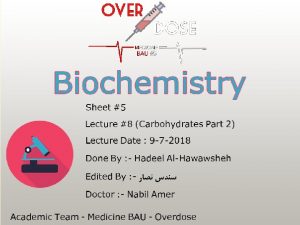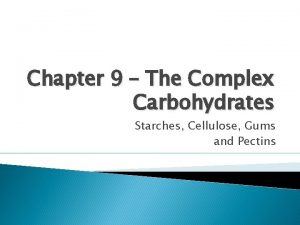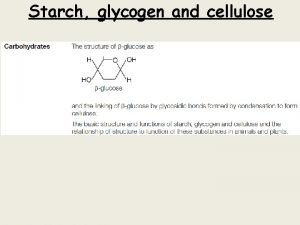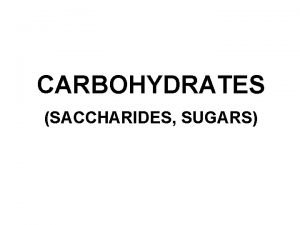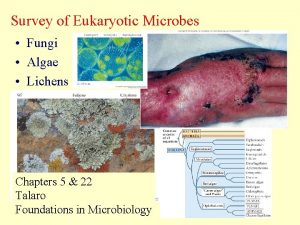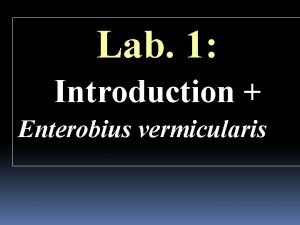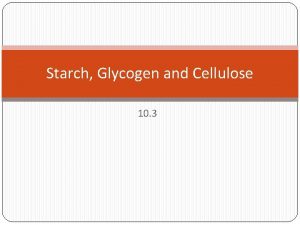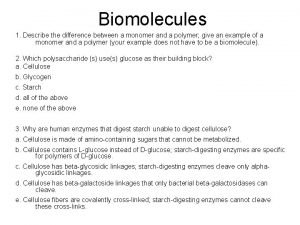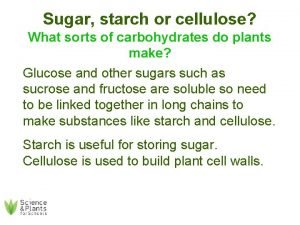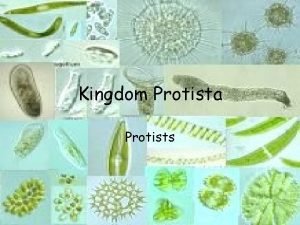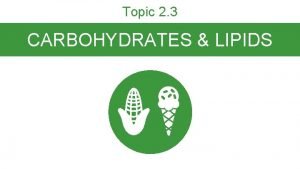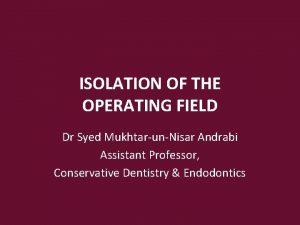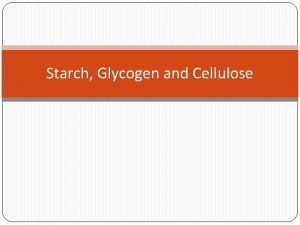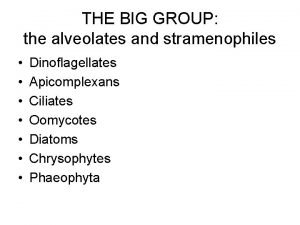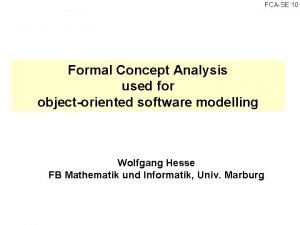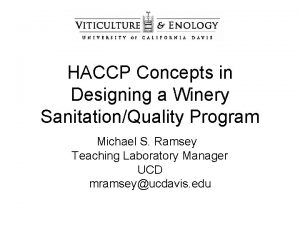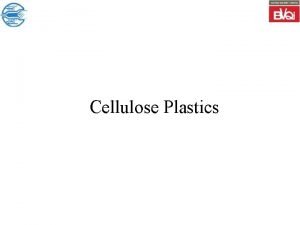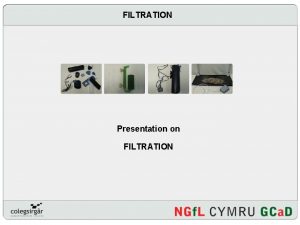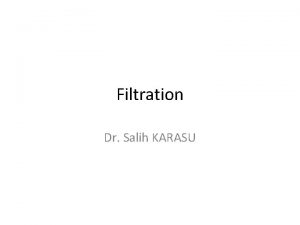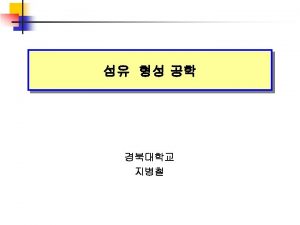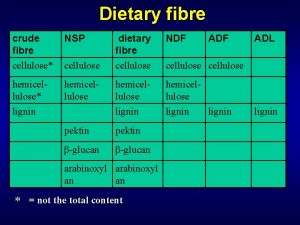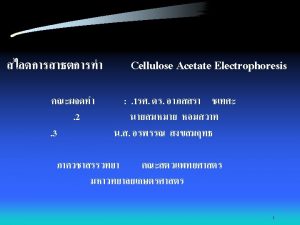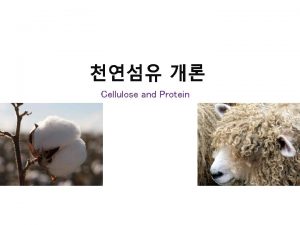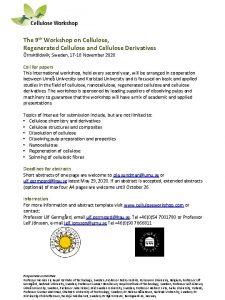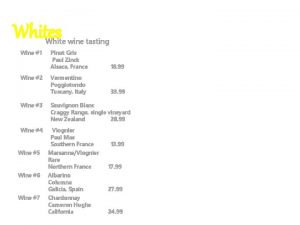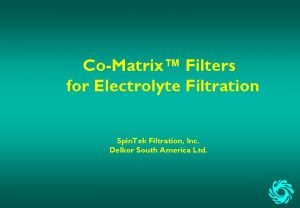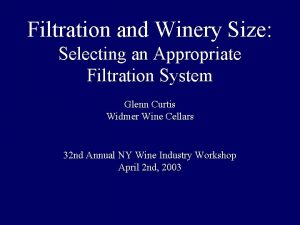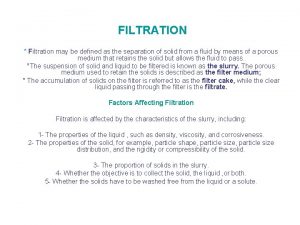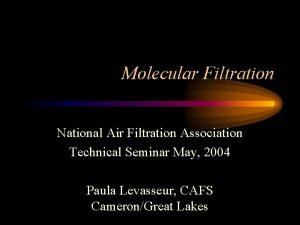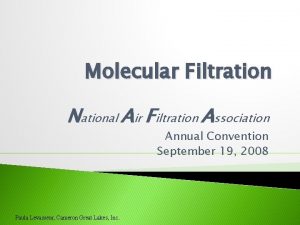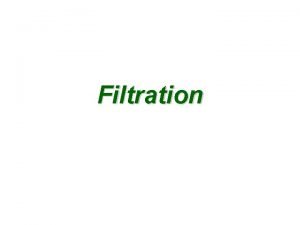Wine filtration with Cellulose Wine filtration with cellulose























- Slides: 23

Wine filtration with Cellulose

Wine filtration with cellulose? ! So far, in wine-making cellulose was only known as. . . u u pressing aid (for lees, deposits from must racking, deacidification deposits) additive for kieselguhrs and perlites Meanwhile, with the „Cellu. Fluxx“ powder celluloses, Erbslöh has developed a new product line to replace kieselguhrs and perlites efficiently and at the same time cost-saving!

Kieselguhrs and perlites / disadvantages u High consumption (thus high wine loss) u Risk to health (calcined and flux-calcined kieselguhrs are classified „carcinogenic“ by IARC / WHO) u Disposal (costly, since partly hazardous waste, high ash content, increased waste volume) u Abrasivity (damage of pumps, filter tissues, etc. ) u Maximum particle size is limited u Content of soluble ions

Cellulose / advantages. . . In comparison, offers the following technical and commercial advantages: u low weight reduced consumption u low consumption u soft fibres less wine loss and waste plants/equipment do not wear out u no crystalline components u purely vegetable not carcinogenic valuable humus, soil improvement

Kieselguhr vs. cellulose Kieselguhr: u high specific weight u close-grained, compact filter cake u high consumption! Cellulose: u light material u porous, open filter cake u very economical consumption! (up to 70 % cost reduction)

Status and results Leading European wineries and sparkling wine producers have already switched their kieselguhr filtration 100 % to cellulose results u on average 70 % reduction of dosage amounts! (. . . that means less waste and less wine loss) u reduced colour loss with cellulose and u more pleasant aroma profile of the cellulose filtered wine u no crystalline components, improved job safety

Cellulose for wine filtration Different fineness for different requirements: u Cellu. Fluxx F 25 for wine filtration u Cellu. Fluxx F 75 (or Cellu. Fluxx P 50) for the filtration of lees u Cellu. Fluxx P 50 specially for vacuum drum filters u Cellu. Fluxx P 30 or Cellu. Fluxx P 50 as additive for fine Cellu. Fluxx F 25 cellulose, kieselguhrs or perlites u Cellu. Fluxx 1500 long fibres as pressing aid

Cellu. Fluxx types / properties Cellu. Fluxx F 25 45 75 Grain size ultra fine extra fine Cellu. Fluxx P 30 Cellu. Fluxx P 50 coarse extra coarse medium Permeability Sharpness of clarification/separation effect Cellu. Fluxx F 45 for wine filtration Cellu. Fluxx P 50 for filtration of lees on vacuum drum filters Cellu. Fluxx P 30 as additive for kieselguhrs, perlites and fine Cellu. Fluxx F 45 types

Vacuum drum filters / Cellu. Fluxx P 50 Vacuum drum filters are frequently used for the filtration of lees Cellu. Fluxx P 50 was specially developed and optimised for use on vacuum drum filters u either to entirely replace kieselguhrs or perlites u or as additive for kieselguhrs or perlites for increased throughput and filter cake stabilisation cellulose as additive – dosage recommendation 400– 500 g/m² Cellu. Fluxx P 50 as thin backing layer for kieselguhrs or perlites resp. as 10– 30 % (w/w) admixture

Case example / Württemberg Spätburgunder (Pinot Noir) First precoating Kieselguhr Cellulose 50 kg coarse kieselguhr 1. 25 kg/m² 50 kg Cellu. Fluxx 1. 25 kg/m² Continuous dosing 400 kg fine kieselguhr (total) (5 x 80 kg) 150 kg Cellu. Fluxx (5 x 35 kg) Consumption 450 kg 200 kg Filtered wine 330, 000 L 420, 000 L Specific consumption 1. 36 g kieselguhr per L wine 0. 48 g Cellu. Fluxx per L wine Filter operating cycle 10 h 12 h Maximum pressure 4 bar

Consumption and wine loss Kieselgur Cellulose u 1 kg filter aid absorbs approx. 1– 2 L wine (study by State Education & Research Center of Viticulture & Horticulture Neustadt, Germany) the filtration of 100, 000 L Pinot Noir requires: u approx. 136 kg kieselguhr. . . consequently a wine loss of 136– 272 L u or approx. 48 kg cellulose. . . consequently a wine loss of merely 48– 94 L Cellu. Fluxx not only saves cash money (reduced consumption), but secures higher profits (increased wine yield)!

Economic efficiency / filtration costs Example

Economic efficiency / filtration costs Would you like to know your additional profit? ! Plus all the other technological advantages!

Waste disposal advantages Resulting filter cake from 100, 000 L Pinot Noir treatment: u 136 kg kieselguhr could easily lead to a 4 -fold amount of filter cake i. e. 544 kg filter sludge (25 % dry matter) u 48 kg cellulose produce merely 192 kg waste (25 % dry matter) Important: cellulose is purely vegetable thus completely biodegradable (valuable humus, material for soil improvement)

Case study – cuvée and sparkling wine filtration Filtered amount cuvée wine 600, 000 L Filtered amount sparkling wine 103, 000 L Total amount 703, 000 L Employed filter cellulose 95 kg Specific consumption 0. 135 g/L Filter operating cycle (passthrough period) 11 ¾ hours Comparison: „usual kieselguhr consumption“ according to winery: u for cuvée filtration approx. 0. 30– 0. 50 g/L u for sparkling wine filtration approx. 0. 50 – 0. 80 g/L (up to 1. 20 g/L)

Cellulose and wine quality Colour loss by precoat filtration (Trollinger, Vernatsch) 25, 0% 20, 0% 15, 0% 10, 0% 5, 0% 0, 0% cellulose filtration kieselguhr filtration

Cellulose and wine quality Cellulose filtered wine tastes significantly better! Tasting by the cellar master taste panel of the LVWO (State Education & Research Center/wine/fruit-growing) Weinsberg, May 21 st 2003 in Weinsberg (preparation and evaluation: Dr. Schmidt and staff) fruit 5 point quality characteristic of the German Food Association clean aromas bitterness filtration with kieselguhr body filtration with cellulose

Cellulose and wine quality Prof. Thilo Hühn, Hochschule (technical college) Wädenswil (CH) evaluates the impact of the filtration on flavour relevant components in wine. Result: u Cellulose removes considerably less aroma substances from the wine. „On the basis of the conducted trials, an impact of the filter aids on the decisive, valuegiving ingredients is ascertainable. . Aroma analysis yields plain results. For most of the tested aroma substances, the wines filtered with kieselguhr present lower contents. Except for sulphur-containing substances, these low aroma concentrations can be evaluated in a negative way (tendency). “

Cellulose and wine quality Prof. Thilo Hühn, Hochschule (technical college) Wädenswil (CH) evaluates the impact of filtration on flavour relevant components in wine Example

Wine filtration: practical application/experience On principle we recommend to build up a backing layer of approx. 400 g/m² Cellu. Fluxx P 30 to start with Precoating Continuous dosage Coarse filtration: (after the 1. racking) 500 -600 g/m 2 Cellu. Fluxx F 45 0. 2 -0. 5 g/L Cellu. Fluxx F 45 „Coarse filtration“: (prior to sheet filter) 800 -1, 000 g/m 2 Cellu. Fluxx F 45 0. 1 -0. 3 g/L Cellu. Fluxx F 45 Fine filtration: 800 -1, 000 g/m 2 Cellu. Fluxx F 25 0. 1 -0. 5 g/L Cellu. Fluxx F 25 (high requirements) (single case: 1. 200 g/m 2 )

Sparkling wine filtration: practical application/experience On principle we recommend to build up a backing layer of approx. 400 g/m² Cellu. Fluxx P 30 to start with Precoating Filtration of base wines: 500 -800 g/m 2 Sparkling wine filtration: 800 -1, 000 g/m 2 High requirements: 800 -1, 200 g/m 2 Continuous dosage Cellu. Fluxx F 75 0. 05 -0. 15 g/L Cellu. Fluxx F 75 Cellu. Fluxx F 45 0. 15 -0. 40 g/L 0. 10 -0. 50 g/L Cellu. Fluxx F 75 Cellu. Fluxx F 45

Wine filtration: first production trials On principle we recommend to build up a backing layer of approx. 400 g/m² Cellu. Fluxx P 30 to start with Aim: first, the adequate Cellu. Fluxx type has to be found! How to proceed ? ! therefore, at first, the original „kieselguhr“ dosage with Cellu. Fluxx in precoating is kept. Continuous dosing according to requirement Clarification sharpness ok, if yes, gradual reduction of Cellu. Fluxx dosage during pressure rise first precoating (minus 10%, . . . ) in subsequent trials. moderate? ! if no, change to another Cellu. Fluxx type. after optimisation, generally dosage savings of 50– 70 % can be achieved with cellulose!

Lees filtration: practical application/experience 3 cellulose types are applied on filter presses: Cellu. Fluxx P 50, Cellu. Fluxx F 75 (resp. Cellu. Fluxx P 30) Precoating Continuous dosage Type „Standard“ requirements: ~0. 8 kg/m 2 1(-3) kg / 100 L Cellu. Fluxx P 50 „High“ requirements: ~0. 8 kg/m 2 1(-3) kg / 100 L Cellu. Fluxx F 75 „Compromise“: ~0. 8 kg/m 2 1(-3) kg / 100 L Cellu. Fluxx P 30 for lees filtration on vacuum drum filters exclusively Cellu. Fluxx P 50 is suitable
 Constant pressure filtration
Constant pressure filtration Cellulose plant
Cellulose plant Starch and liquid combinations
Starch and liquid combinations Condensation of beta glucose
Condensation of beta glucose Simple saccharides
Simple saccharides Aseptate
Aseptate Roundworm cross section
Roundworm cross section Surfathix
Surfathix Starch and glycogen
Starch and glycogen Glycogen vs starch vs cellulose
Glycogen vs starch vs cellulose Schulze's test for cellulose
Schulze's test for cellulose Plants are multicellular eukaryotes
Plants are multicellular eukaryotes Zooflagellates
Zooflagellates Storage of carbohydrates
Storage of carbohydrates Cellulose introduction
Cellulose introduction Cellulose wafers dentistry
Cellulose wafers dentistry Difference between starch glycogen and cellulose
Difference between starch glycogen and cellulose Define permiation
Define permiation Stramenophiles
Stramenophiles Ito ay ginagamit sa pagsukat ng tela.
Ito ay ginagamit sa pagsukat ng tela. Amoroni wine
Amoroni wine Planets named after roman gods
Planets named after roman gods Lunzer wine events
Lunzer wine events Haccp for wine production
Haccp for wine production

